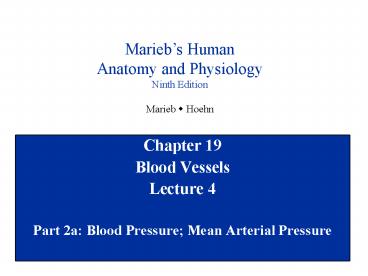Blood Vessels
1 / 9
Title: Blood Vessels
1
Mariebs Human Anatomy and Physiology Ninth
Edition Marieb w Hoehn
- Chapter 19
- Blood Vessels
- Lecture 4
- Part 2a Blood Pressure Mean Arterial Pressure
2
Some Blood Flow Preliminaries
- Blood flow is the volume of blood that flows
through any tissue in a given amount of time - Total blood flow CO (ml/min)
- Two important factors influence how the CO gets
distributed to the body - Pressure that drives the blood through a tissue
- Resistance to blood flow (OPPOSES FLOW)
- Blood Flow (CO) ? Pressure / Resistance
3
Vascular Resistance
- The resistance to blood flow (vascular
resistance) is dependent upon several factors - Size of the lumen of the blood vessel (R? 1/r4)
- Smaller lumen more resistance to flow
- Larger lumen less resistance to flow
- Main physiological control of resistance and
flow - Blood viscosity (thickness) which is determined
by the ratio of RBCs to plasma - Increased viscosity more resistance to flow
- Total blood vessel length (Lets gain a few
pounds 200 MILES / pound of adipose!) - Longer total blood vessel length more
resistance to flow - Turbulence (increased turbulence more
resistance)
Recall Blood Flow (CO) ? Pressure / Resistance
4
Arterial Blood Pressure
Blood Pressure force the blood exerts against
the inner walls of the blood vessels
- Arterial Blood Pressure
- rises when ventricles contract
- falls when ventricles relax
- systolic pressure maximum pressure
- diastolic pressure minimum pressure
Pulse pressure difference between systolic and
diastolic pressures (systolic diastolic pulse
pressure 321) - Pulse pressures usually rise
with age because of an increase in blood vessel
(aortic) resistance (arteriosclerosis)
5
Mean Arterial Pressure
Mean Arterial Pressure (MAP) Average effective
pressure driving blood flow through the systemic
organs MAP CO x Total Peripheral
Resistance (TPR) Thus ALL changes in MAP
result from changes in either cardiac output or
peripheral resistance If CO increases, MAP ?
If TPR decreases, MAP If TPR
decreases, what must be done to keep MAP the
same? If blood volume decreases, what must
be done to keep MAP the same? MAP can be
estimated by the equation diastolic bp
(pulse pressure / 3) (Roughly 1/3 of the
way between systolic and diastolic pressures)
6
Pulse
A pulse is a rhythmic pressure wave
accompanying each heartbeat.
Figure from Holes Human AP, 12th edition, 2010
The alternate expanding and recoiling of the
arterial wall that can be felt (palpated) easily
at certain locations on the body
7
Factors That Influence Arterial Blood Pressure
BP (MAP) Cardiac output x Peripheral Resistance
Figure from Holes Human AP, 12th edition, 2010
CO
Know this!
TPR
Decrease in the above factors has the opposite
effect, i.e., blood pressure decreases
8
Central Venous Pressure
- Central Venous Pressure pressure in the vena
cava near the right atrium ( 2-4 mm Hg) - determines the filling pressure of the right
ventricle - determines the EDV of the right ventricle which
- determines ventricular stroke volume
(Frank-Starling) - affects pressure within the peripheral veins
- weakly beating heart causes an increase in
central venous pressure (backup of blood) - increase in central venous pressure causes blood
to back up into peripheral veins
9
Review
- Blood pressure
- Is the force exerted on vessel walls by the blood
- Is usually measured as arterial blood pressure
- Systolic maximum pressure during ventricular
systole - Diastolic minimum pressure during ventricular
diastole - Pulse pressure systolic diastolic
- Mean arterial pressure CO X TPR































